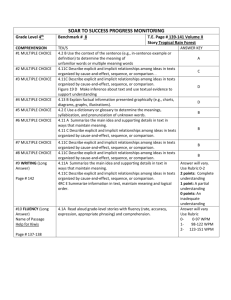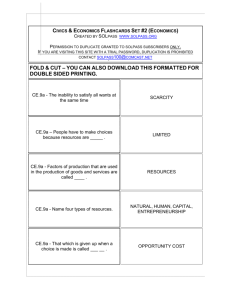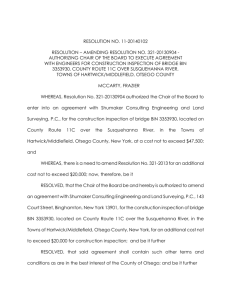Supplementary Data
advertisement
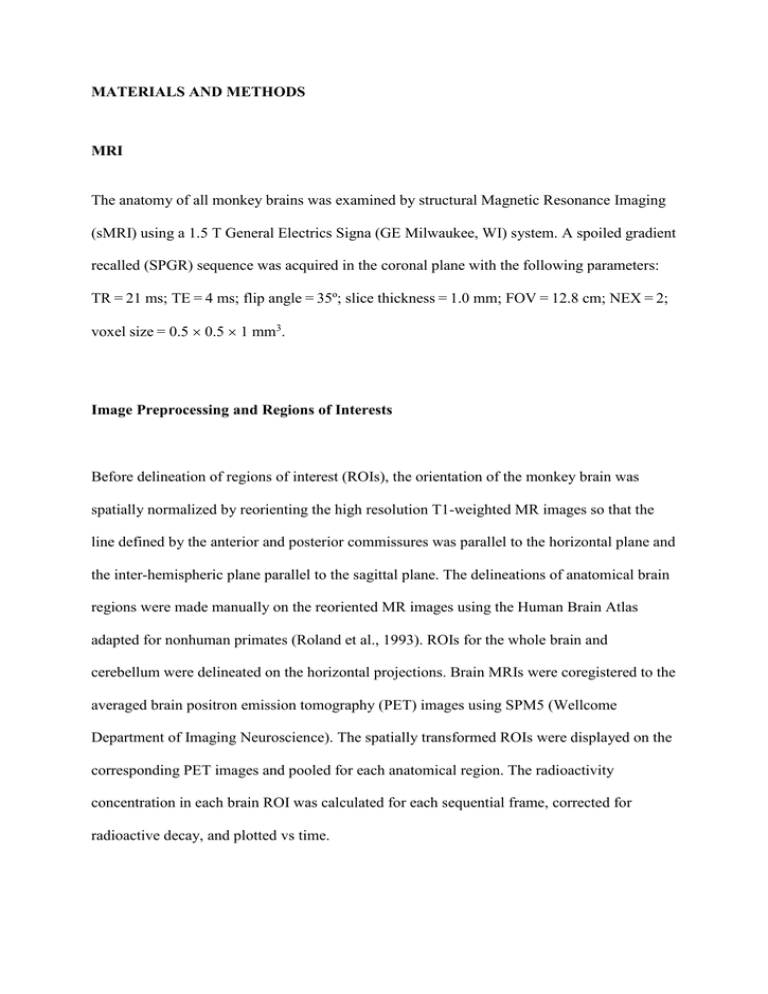
MATERIALS AND METHODS MRI The anatomy of all monkey brains was examined by structural Magnetic Resonance Imaging (sMRI) using a 1.5 T General Electrics Signa (GE Milwaukee, WI) system. A spoiled gradient recalled (SPGR) sequence was acquired in the coronal plane with the following parameters: TR = 21 ms; TE = 4 ms; flip angle = 35º; slice thickness = 1.0 mm; FOV = 12.8 cm; NEX = 2; voxel size = 0.5 0.5 1 mm3. Image Preprocessing and Regions of Interests Before delineation of regions of interest (ROIs), the orientation of the monkey brain was spatially normalized by reorienting the high resolution T1-weighted MR images so that the line defined by the anterior and posterior commissures was parallel to the horizontal plane and the inter-hemispheric plane parallel to the sagittal plane. The delineations of anatomical brain regions were made manually on the reoriented MR images using the Human Brain Atlas adapted for nonhuman primates (Roland et al., 1993). ROIs for the whole brain and cerebellum were delineated on the horizontal projections. Brain MRIs were coregistered to the averaged brain positron emission tomography (PET) images using SPM5 (Wellcome Department of Imaging Neuroscience). The spatially transformed ROIs were displayed on the corresponding PET images and pooled for each anatomical region. The radioactivity concentration in each brain ROI was calculated for each sequential frame, corrected for radioactive decay, and plotted vs time. Materials O-desmethyl sulpiride was obtained from lgc standards AB, N-desmethyl doxepin was obtained from PharmaSynth AS, N-desmethyl citalopram was obtained from TLC PharmaChem Inc., and N-desmethyl sertraline was obtained from Toronto Research Chemicals Inc. Other drug standards, precursors, and chemicals were obtained from SigmaAldrich and used without further purification. Radiochemistry and Quality Control [11C]Methane was produced at the Karolinska University Hospital with a General Electrics Medical Systems PETtrace cyclotron using 16 MeV protons in the 14N(p.α)11C reaction on nitrogen gas. [11C]Methyl iodide was synthesized by recirculating [11C]methane through heated iodine in an in-house developed apparatus as described elsewhere (Larsen et al., 1997). [11C]Methyl triflate was in its turn prepared by sweeping [11C]methyl iodide vapor through a heated glass column containing silver-triflate impregnated on graphitized carbon, as previously described (Jewett et al., 1997). Radiolabeling of all 13 reference drugs was achieved by trapping the alkylating agent (11C-labeled methyl iodide or triflate) at room temperature in a reaction vessel containing the appropriate reaction mixture. After completed entrapment and reaction, radiolabeled drugs were purified using semipreparative high performance liquid chromatography. During separations, the high performance liquid chromatography column outlet was connected to an absorbance detector ( = 254 nm) in series with a GM-tube for radiation detection. The product fraction was collected and isolated by on-line evaporation using a carburetor or by solid phase extraction. Radiolabeled drugs were formulated in a 5% solution of ethanol in phosphate buffered saline (pH 7.4) or in a mixture of phosphate buffered saline and 30% propylene glycol in ethanol (5:3, vol/vol). Finally, the product formulation was sterilized via membrane filtration through a 0.22-µm Millipore filter (Waters). The radiochemical purity of each product was determined by reverse phase HPLC equipped with an absorbance detector ( = 254 nm) in series with a -flow detector (Beckman) for radiation detection. The radiochemical identity of each radiolabeled drug was determined prior to administration by co-injection with the authentic drug standard. The chemical identity of the radiolabeled product was confirmed after the product had decayed by ultra-performance tandem mass spectrometry analysis of the carrier associated with the radioactive product. Drug Formulations Drugs were formulated for intravenous administration in their appropriate vehicles and sterilized through membrane filtration (Millipore 0.22 µm, Waters) on the day of the experiment. Drug retention on the sterile filter was assessed by HPLC analysis of drug concentration in the formulation prior and post filtration. REFERENCES Jewett DM, Kilbourn MR, Lee LC (1997) A simple synthesis of [11C]dihydrotetrabenazine (DTBZ). Nucl Med Biol 24:197–199. Larsen P, Ulin J, Dahlstrom K, Jensen M (1997) Synthesis of [C-11]iodomethane by iodination of [C-11]methane. Applied Radiation and Isotopes 48:153–157. Roland PE, Graufelds CJ, Wǎhlin J, Ingelman L, Andersson M, Ledberg A, Pedersen J, Åkerman S, Dabringhaus A, Zilles K (1993) Human brain atlas: for high-resolution functional and anatomical mapping. Human Brain Mapping 1:173–184. Reference drug Caffeine Citalopram Clomipramine Clozapine Diazepam Doxepin Morphine Nicotine Pharmacological target Adenosine receptor Serotonin transporter Serotonin transporter Multiple Gamma-aminobutyric acid receptor Histamine H1 receptor Opioid receptors Nicotinic acetyl choline receptor Functional activity Antagonist Inhibitor Inhibitor Antagonist. agonist Positive modulator Antagonist Agonist Agonist Action CNS stimulant Antidepressant Antidepressant Antipsychotic Anxiolytic Anxiolytic. antidepressant Analgesic CNS stimulant Brønstedt class Base Base Base Neutral Neutral Base Base Base Seligiline Sertraline Sulpiride Monoamine oxidase type B Serotonin transporter Dopamine D2/D3 receptors Irreversible inhibitor Inhibitor Antagonist Anti-parkinson drug Antidepressant Antipsychotic Base Base Base Venlafaxine Serotonin/norepinephrine transporter Inhibitor Antidepressant Base Verapamil Calcium channel Blocker Antiarrhythmic Base SUPPLEMENTAL TABLE 1. Reference drugs for PET microdosing. Brønstedt class refers to the propensity of the drug to be a proton acceptor or donor at physiologic pH 7.4. SUPPLEMENTAL FIGURE 1. Two-tissue compartment model for the disposition of radioactivity in brain following administration of a microdose of radiolabeled drug. K1 is expressed in mL cm3-1 min-1 and k2, k3 and k4 are expressed in min-1. Drug [11C]Caffeine [11C]Citalopram [11C]Clomipramine [11C]Clozapine [11C]Diazepam [11C]Doxepin [11C]Morphine [11C]Nicotine [11C]Selegiline [11C]Sertraline [11C]Sulpiride [11C]Venlafaxine [11C]Verapamil Cmax, %ID Cmax, SUV brain brain (%ID) (SUV) 5.0 4.6 4.0 3.0 3.2 2.8 2.9 2.7 3.6 2.7 3.7 3.4 5.2 3.9 3.5 3.7 2.5 2.2 4.2 3.1 5.6 5.7 5.5 5.3 1.1 1.0 1.2 1.1 6.2 5.7 5.1 4.7 3.7 2.7 4.8 4.5 4.8 4.9 4.3 4.1 1.4 1.3 1.3 1.2 2.0 1.8 3.9 2.9 1.3 1.2 1.0 1.0 Tmax brain (min) 1.3 0.8 35 54 42 42 32 54 3.5 1.8 36 42 0.17 0.17 2.5 7.5 NA 2.5 90 102 0.2 0.2 11 17 0.75 0.75 SUPPLEMENTAL TABLE 2. Pharmacokinetic parameters for intravenously injected microdoses of 11C-labeled drugs in two different cynomolgus monkeys. AUC brain0-90min/AUCplasma0Dose Drug (mg/kg) 11 [ C]Caffeine micro 2.5 11 [ C]Citalopram micro 3 11 [ C]Clomipramine micro 0.8 11 [ C]Clozapine micro 1.5 11 [ C]Diazepam micro 2 11 [ C]Doxepin micro 0.1 11 [ C]Morphine micro 0.5 11 [ C]Nicotine micro 0.12 11 [ C]Selegiline micro 0.5 11 [ C]Sertraline micro 1 11 [ C]Sulpiride micro 2 11 [ C]Venlafaxine micro 2 11 [ C]Verapamil micro 0.3 90 min (KP) 0.75 0.76 11.7 11.7 20.1 20.7 11.9 9.6 2.0 1.7 25.5 20.9 0.36 0.19 5.5 6.3 11.2 5.9 24.6 25.5 0.0029 0.0022 8.0 8.3 3.2 2.7 VT Difference relative to (KP) VT (%) 0.77 -2.7 0.80 -4.6 21.6 -46 17.4 -33 41.8 -52 35.4 -42 16.5 -27 13.0 -27 2.6 -23 1.8 -2.3 46 -44 29.1 -28 NA NA NA NA 8.4 -34 8.8 -29 NA NA 12.2 -51 68.4 -64 66.0 -61 NA NA NA NA 10.3 -22 11.4 -27 6.5 -50 2.8 -1.0 SUPPLEMENTAL TABLE 3. Comparison of brain/plasma partition coefficients obtained using the AUC ratio method (AUC brain0-90min/AUCplasma0-90 min) and kinetic modeling (VT). Drug Condition parent fraction parent (2.5 fraction min) (45min) Caffeine Microdose Pharmacologic dose Microdose Pharmacologic dose Microdose Pharmacologic dose Microdose Pharmacologic dose Microdose Pharmacologic dose Microdose Pharmacologic dose Microdose Pharmacologic dose Microdose Pharmacologic dose Microdose Pharmacologic dose Microdose Pharmacologic dose Microdose Pharmacologic dose Microdose Pharmacologic dose Microdose Pharmacologic dose 0.98 0.98 0.83 0.78 0.84 0.92 0.97 0.97 0.94 0.91 0.96 0.96 0.13 0.16 0.95 0.91 0.92 0.88 0.96 0.95 0.99 0.99 0.97 0.92 0.96 0.98 Citalopram Clomipramine Clozapine Diazepam Doxepin Morphine Nicotine Selegiline Sertraline Sulpiride Venlafaxine Verapamil 0.97 0.963 0.45 0.45 0.16 0.15 0.44 0.43 0.2 0.25 0.17 0.14 0.04 0.05 0.13 0.11 0.14 0.11 0.32 0.32 0.89 0.83 0.19 0.18 0.16 0.19 SUPPLEMENTAL TABLE 4. Data on parent 11C-labeled drug in plasma at two time-points after intravenous injection into rhesus monkeys.
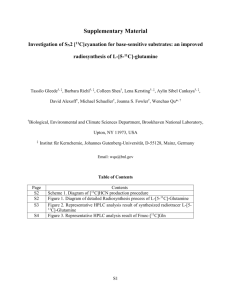
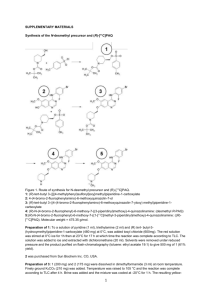
![ACCURACY OF [11C] CHOLINE POSITRON EMISSION](http://s3.studylib.net/store/data/006910188_1-178035aba028502f62a71ecfd059e7d4-300x300.png)
![[125I] -Bungarotoxin binding](http://s3.studylib.net/store/data/007746915_2-24484224552cb6e93390ec53e82e3abc-300x300.png)

